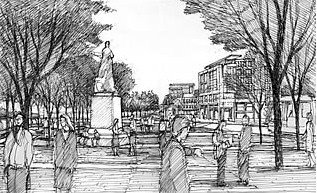Envisioning a West Main Transformed
West Main Street in Charlottesville has long served as a corridor connecting the University of Virginia with downtown. Now, in a new exhibit, a team of Wahoo architects and planners envision the street as a destination in its own right.

Through a series of site studies, the "Destination: WEST MAIN" exhibit depicts West Main as it could look if it were redeveloped into "compact, mixed-use, walkable places that enliven the city’s core," according to an article in UVa Top News Daily. "The work highlights the integral link between land-use and transportation by examining how a modern streetcar system could shape development along this central corridor."
.jpg)


5 Comments:
OK here are a few numbers.
In Madison, Wisconsin the proposed streatcar system will cost 242 million dollars with O&M costs of 39 million per year or 10 million per year more than the current bus system.
Some construction costs: Galveston; 15.18, Seattle, 18.82; San Jose, 28.64. That's million per mile, folks. Seattle was later revised upward to 24 million per mile. San Farnciscos new construction was 30 million per mile.
Ridership. Dallas, 5.1; Memphis, 5.4; Galveston, 5.6; Seattle, 6.4; Tuscon 6.8. That's passengers per mile operated.
In Seattle the trolley would operate 6 mph slower than buses and cost 30% more. It would run 3.6 miles and cost 45 to 50 million of which adjacent property owners would pay 25 million. Not a bad deal since their value would rise 56 million. It would carry 60 - 70 passengers per hour who would pay a grand total of 10% of the operating costs. Meanwhile, the existed bus system operate 3000 empty seats per hour, so the plan is to raise money for 3.6 miles of trolly by cutting service on 300 miles of bus routes.
There is no doubt a streetcar would shape development, and it might even make sense in Charlottesville.
As always, the question is, Who will pay? Judging from these numbers it would be hard to remain a fiscal conservative and support trolley service.
Travel from Washington to Providence and back for two people for Thanksgiving costs $440 by Air and takes 6 hours including transfers, by rail on the Acela Express it takes 9-10 hours and costs $640, by car it takes 8.5-9.5 hours and costs $238, but the marginal cost is only $150, given that the car and insurance is paid for anyway.
The rail price is heavily subsidized, but even if all external costs were charged to the car, it would still be less than $400.
More than 80% of holiday travelers will go by car. Is it any wonder?
this Rail stuff gets better and better. The feds popped some more money for the Gainesville VRE extension.
Current figures for that extension are that it will cost $56,000 per rider in new capital cost (likely to double before we finish) and another $1600 to $2000 per year in annual operating cost subsidies.
For that kind of money you might be able to locate who those riders would be and just subsidize them to buy homes in the new Metro West project.
Of course, the induced traffic argument says that someone else would just move into the homes they vacated, so this solution does nothing for traffic congestion.
Somehow, paying $284 million dollars to induce more people to drive to Gainesville does not sound like it is going to help traffic there very much.
I think some Hokie-stone would improve the viewshed on this proposal. :)
I seem to stuck on one train of thought.
In Gainesville, $160 million of the reason for the enormous cost is because grade separation is required to keep the train from snarling traffic even worse than it is. This means that route 29 and route 66 will have to be rebuilt in that area.
This could be hidden factor in the cost of many rail proposals. If the rail systems increase the cost or reduce the flow on road systems, I think that is what auto critics call an externality.
Street level trolleys, like the one proposed for Charlottesville often use technology to ensure that the train always has a green light. This interferes with the traffic light timing scheme and causes increased delay for auto traffic.
The reason the San Francisco project was so expensive was that, like Charlottesville, it included a lot of street beautification. Properly speaking, that should not be charged against the rail system, but against the parks budget or some such.
I applaud this part of the project. I thinke we should put the "park" back in parking lots and parkways. It is a lot harder to criticize construction if we work to make it beautiful.
Post a Comment
<< Home